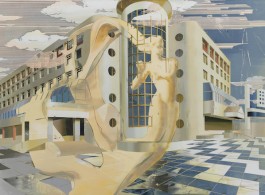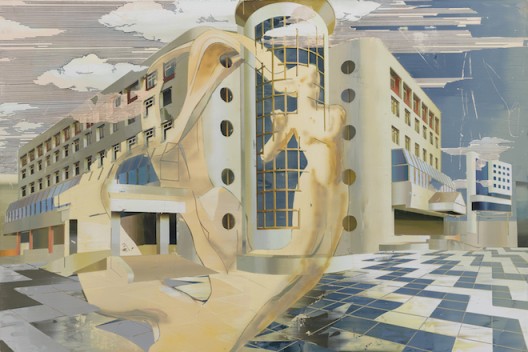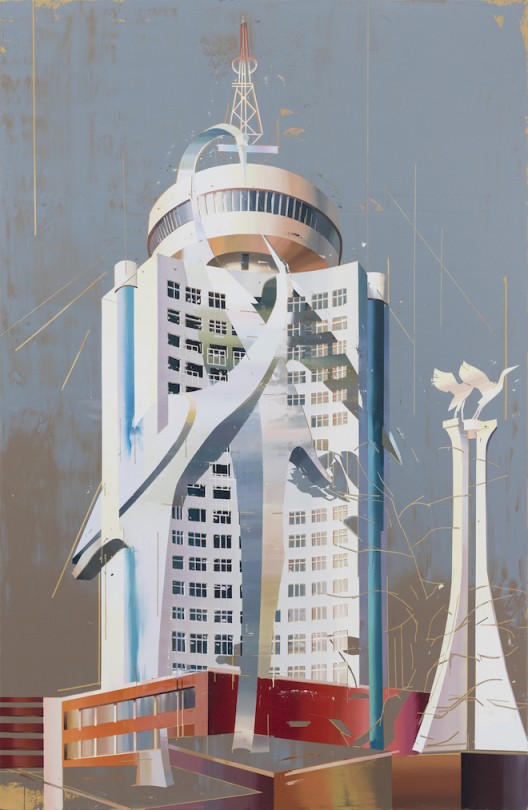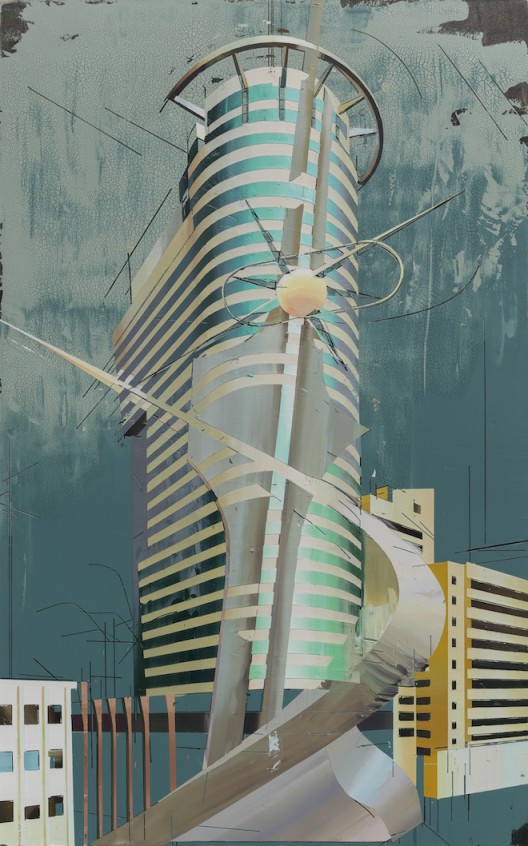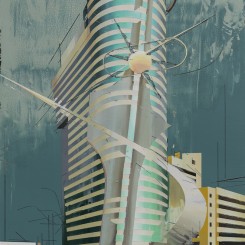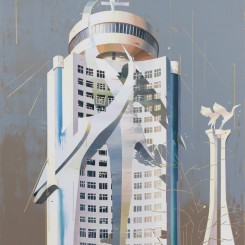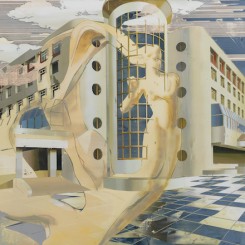“Latter, Former”
MOTHER’S TANKSTATION
Dublin
As a possible consequence of the common art world syndrome of overly-regular air travel, I find that I have become an un-anticipated fan of the twenty-something-word film synopsis, to be found either in the in-flight entertainment magazines or as teasers on the screen of your ‘personal console’. In the hope that such minimalistic discipline might sharpen written work, I have begun to research, as through the usual sources (on-line guides), into the razor-like world of such concise, evocative descriptors. Importantly, the first point seems to encourage objective distance: 4
What?…you may legitimately enquire, does super-synopsizing have to do with the super-important, first European showing of the very exceptional Beijing-based painter, Cui Jie, at mother’s tankstation limited? Answer: on the basis of concision, it is simply impossible to compete with a Hans-Ulrich Obrist instagram, on the occasion of his curated pop-up show, HACK SPACE, for Kl I Foundation, Hong Kong1 (which included Cui Jie’s work). Obrisfs instagram consisted of a characteristic photograph of a Post-it note, evidencing the handwriting of the artist, with three overwritten words (layered one over the other); <<architecture,5, <<sculpture,,> <<painting,,> beside which sat the English form of her signature. Everything you need to know, personage, source and structures, laid bare. Form+language, purpose+process = constructed outcome. Simultaneously, one builds upon the other, whilst knocking the whole lot down.The rubble of constituent parts… Writers of the synopsis form; place your heads in your hands and weep hot tears (fifteen words). I too accept defeat and head off towards the longer version of possible, actual, events (just the facts).
The building (body of work) of Cui Jie, Latter, Former, is molded from four iconographic, vertical oil on linen paintings of buildings, in their architectonic magnificence, hosting nostalgically futuristic lone towers dissolving into the painterly representations/deconstructions (building while knocking down) of municipal spaces; sculptures, overpasses and the bare, spiky skeletons of the oh-so-distinctive Shanghai trees2. Further; five impossible drawings in coloured pencil, a suite of seven digital prints and masking tape collages, set onto stripped-out book pages of Rem Koolhaas and Hans-Ulrich Obrisfs Project Japan. Metabolism Talks…3. Architecture, sculpture, painting. The body of work completes, with a small, spare, rare and precious 2010 painting of the artist’s (former) Beijing studio interior (lovingly hand carried on one of the above-referred long-haul flights). Form rendered in three substantial planes of directional light; wall, door, floor, Nothingness* behind. A synopsis that flows in story style; the complexities of three-dimensional atmosphere emotively collapsed into the simplicity of 2-D rendering. The space behind the wall, houses a lurking mystery of darkness (eleven words).
Considered one of the most promising painters of the Chinese “post-80s generation’’,4 Cui Jie’s extraordinary paintings source combinations of idealized urban architecture, finding commonalities that merge contemporary Beijing and post-war, Communist DDR. Consequently the colours and forms seem, simultaneously, strange and familiar, equally to eastern and western eyes. Beijing and Berlin, seen through a vision of Pittura metafisica? City plans and multiple exposures are captured in deposits of Sculptural impasto,, slowly piled, masked and contained to embody the transformations of China’s urbanscape, through human mountains of time and politics, history and reason. The skies into which high-rise blocks sink, dissolve, fuse the romantic sublime of a Turner sunset (against the steam and smoke of industrial revolution) with the contemporary urban realities of hyper-industrial, super-pollution. Former, latter.
The architectural vernacularisms, clearly distinctive to Chinese megalopolises, share municipal space with modernist sculptures that bespeak the new found freedoms of the Chinese reformist, capitalist era and the embraced adoption of western forms, that dream in utopian vision space. However, architectures, sculptures, their embedded metaphors, are visually and symbolically distinct from their western counterparts – in purpose, intent and compositional style. The western devotion to the hegemony of the rectangle, form and function – horizontal and vertical intersections – is built upon and simultaneously knocked down by the joy of curves, loops, circles, metaphors of animals (building of Cranes, building of Eagles). East re-imagines West, West re-imagines it right back. Michel de Certeau, pre-empts this in looking at a distinction between usage and consumption: “To a rationalized, expansionist, and at the same time centralized, clamorous, and spectacular production corresponds another production called “consumption.” The latter is devious, it is dispersed, but insinuates itself everywhere, silently and almost invisibly, because it does not manifest itself through its own products, but rather through its ways of using the products imposed by a dominant economic order.”
Cuijie*s paintings continuously write, re-write, synopsize, re-synopsize their own cultural stories, our cultural stories, submitting a twenty-something-word “police report”,while simultaneously creating precise, concise, totally memorable and poetically lustrous images…to be seen, to be felt.
1 The KI I Art Foundation (KAF) and Serpentine Gallery, London, collaborative ‘pop-up* group exhibition HACK SPACE, featured the work of New Zealand artist Simon Denny together with I I China-based artists: aaajiao, Cao Fei, Cui Jie, Guo Xi, Hu Qingtai, Firenze Lai, Li Liao, Liang Shuo, Tao Hui, Xu Qu and Zhai Liang. KI I Art Foundation Pop-up Space, G/F, Cosco Tower, 33 Wing Lok Street, Sheung Wan, Hong Kong, 21.3.2016-24.4.2016. Co-curated by Hans-Ulrich Obrist and Amira Gad, HACK SPACE was a re-envisioned, re-iteration and expansion of Denn/s exhibition Products for Organising previously held at the Serpentine Galleries. The exhibition took at its core the theme of hacking space – the idea that place, territory and infrastructure can be radically adapted in unorthodox ways to solve problems. Through an unconventional organisational, social and spatial arrangement, the hacker-like uShan ZhaiM principle is an underlying link between the exhibited works in HACK SPACE. Drawing themes from the original, which compared hacking culture and innovation in different contexts, the exhibition collided practices that uquestion, cheat, flip, redefine and short-cut notions of space, buildings and creative practices”.
2 Shanghai is Cui Jie^ native city. The tree form, most common to Cui Jie’s imagery almost reads like a subverted Chinese, art historical ink drawing, a ricked pine; in Chinese art history the Pine is an evergreen, and considered to be a symbol of longevity. Together with plum blossom and bamboo, pine is commonly included in paintings honoring the New Year and the three are called Friends of the New Year. It is often depicted with crane, symbols of love, loyalty and good fortune.
3 Between 2005 and 2011, architect Rem Koolhaas and curator Hans Ulrich Obrist interviewed the surviving members of Metabolism—the first non-western avant-garde, launched in Tokyo in I960, in the midst of JapanJs postwar miracle. Tcschen, 2011. The publisher’s synopsis reads:”Project Japan features hundreds of never-before-seen images—master plans from Manchuria to Tokyo, intimate snapshots of the Metabolists at work and play, architectural models, magazine excerpts, and astonishing sci-fi urban visions—telling the 20th century history of Japan through its architecture, from the tcbulc rcsc of a colonized Manchuria in the 1930s to a devastated Japan after the war, the establishment of Metabolism at the I960 World Design Conference in Tokyo, to the rise of Kisho Kurokawa as the first celebrity architect, to the apotheosis of Metabolism at Expo *70 in Osaka and its expansion into the Middle East and Africa in the 1970s. The result is a vivid documentary of the last moment when architecture was a public rather than a private affair”.
4 Post-80s: is a colloquial term, which refers to the generation, especially in urban cities, whose members were born between 1980 to 1989 in China after the introduction of the One-child policy. This generation, the first to grow up entirely within the reformist era, currently ranges in age from 26 to 36, making up a major portion of China’s young adult demographic.
5 Michel de Certeau, The Practice ofEyerydcy Life, University of California Press, 1984, Pg. xii-xiii

